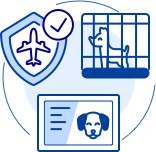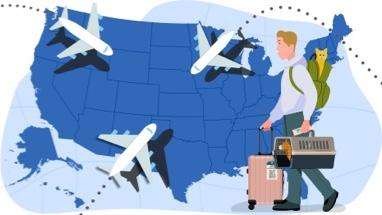Pet travel from the U.S. to Finland, Malta, Ireland, (including Northern Ireland*) and Norway - Requirements
Welcome! This page will guide you through the rules and requirements for traveling internationally with your pet.
Before You Start the Process
Find a USDA-Accredited Veterinarian
With help from a USDA-accredited veterinarian, you can learn more about your destination country's entry requirements for pets, including any needed vaccinations, tests, or treatments. We recommend creating a schedule to make sure you meet all requirements within the specified timeframe.
Gather This Information for Your USDA-Accredited Veterinarian
- The type of pet traveling
- The destination country
- If applicable, countries where your pet will stop (for customs clearance or upon leaving the airport or seaport) on the way to the destination country
- The date of departure from the United States
- Whether the pet will be traveling alone, as cargo, or with a person in the cabin of the plane
- Note: If you're traveling with a pet bird or exotic animal, you may need to work with additional agencies, such as the U.S. Fish and Wildlife Service (1.41 MB) and Centers for Disease Control and Prevention.
Read These Resources
- Pet Travel Guidance for Pets Traveling to Another Country From the United States
- In Spanish (En Español): Guía de viaje para mascotas que viajan a otro país desde Estados Unidos
- In Chinese (用中文(表達): 宠物出国旅行指南
- Frequently Asked Questions About Traveling With Your Pet
Travel Requirements Based on Pet Type
Microchip
- Your pet must have a working microchip (also called a “transponder”) before getting its rabies vaccination for travel to the EU, and your veterinarian must always scan the microchip before giving your pet a rabies vaccination.
- If your pet does not yet have a microchip or has a microchip that doesn’t work, ask your veterinarian to implant an ISO-compliant* microchip.
- If your pet has a working microchip, but it is not ISO compliant,* you will need to travel with your own scanner that can read the microchip OR have a second microchip implanted that is ISO compliant.* Make sure both microchips are listed on the health certificate!
*ISO-compliant microchip numbers are usually 15 digits long and meet specific international standards (ISO 11784 and ISO 11785). You can check ISO-compliance with the microchip manufacturer.
Rabies Vaccination
“Primary” Rabies Vaccination:
- The first rabies vaccination your pet gets after its microchip or after any lapse in coverage is a “primary” rabies vaccination according to EU rules.
- For all pets vaccinated in the United States, a “primary” rabies vaccination is only valid for 1 year. Even if your pet is an adult animal and receives a three-year vaccine, if it is a “primary” rabies vaccination according to EU rules, it is only valid for 1 year.
- If your pet does not receive another rabies vaccination within 1 year of a “primary” rabies vaccination, it means the vaccination coverage lapsed and you must start over. Even if the vaccination coverage only lapses by a day, the next rabies vaccination is again considered a “primary” rabies vaccination, and it is only valid for 1 year.
“Booster” Rabies Vaccination:
- If your pet does get its next rabies vaccination within 1 year of a “primary” rabies vaccination, this “booster” rabies vaccination can be valid for 1-3 years, according to the vaccine manufacturer’s instructions.
Note: If your pet’s most recent rabies vaccination before traveling to the EU is a “booster” rabies vaccination (rather than “primary”), you are responsible for providing all relevant rabies vaccination certificates to prove there was no lapse in coverage since the "primary" rabies vaccination.
Reminder! Rabies Vaccinations do NOT count according to EU rules if:
- Your pet got the vaccination before it had a microchip; or
- Your pet got the vaccination without first having its microchip scanned.
Your pet should travel with all relevant rabies vaccination certificate(s), and it is strongly recommended the microchip number is recorded on all rabies vaccination certificate(s).
21-Day Waiting Period
After any "primary" rabies vaccination, your pet must wait 21 days before traveling to the EU. Your pet can travel to the EU less than 21 days after a “booster” rabies vaccination, but then the previous rabies vaccination must also be included on the health certificate.
If your pet is less than 16 weeks old and cannot meet the above requirements, click here.
Want to simplify your paperwork?
Ask your veterinarian to give your pet a 1-year rabies vaccination (after scanning the microchip) at least 21 days before your travel to the EU but less than one year before your travel date (for example, 3-6 months before travel date). That way, no matter the rabies vaccination history, you only need to keep up with one vaccination certificate instead of several! Doing it this way also makes it easier for the USDA endorsement office to review, which means you get your endorsed certificate back faster.
Important
The EU has two versions of the pet health certificate: the "non-commercial" and the "commercial." Both health certificate versions require an Accredited Veterinarian to issue (complete, sign, and date) the health certificate and then USDA to endorse (countersign and emboss/stamp) the health certificate before your pet's travel. However, it is much easier to meet the timeframes for the "non-commercial" health certificate than the "commercial" health certificate, so keep this in mind when arranging your pet's travel.
"Non-commercial" Health Certificate
- You should use the "non-commercial" health certificate if you or a designated person** is traveling within 5 days before or after your pet(s), and 5 or fewer pets are traveling.
- Though uncommon, you can also use the "non-commercial" for 6 or more pets traveling to the EU for specific events like competitions, exhibitions, or sporting events.
- The "non-commercial" health certificate is valid for 30 days after the Accredited Veterinarian issues it.
- The USDA must endorse the completed health certificate within ten days of arriving in the EU. See STEP 3 below for more information on the endorsement.
Declaration: The final page of the EU Health Certificate contains a Declaration that must be completed and signed by the pet owner or designated person** before the pet travels to the EU. The Declaration must accompany the pet and health certificate to the EU.
- Note: You may use the “non-commercial” EU health certificate to travel within the EU for up to 4 months as long as your pet’s rabies vaccination does not expire. If you take your dog to Finland, Malta, Ireland (including Northern Ireland) or Norway after entering the EU, your dog must be treated for tapeworms by an EU veterinarian 1-5 days before entering those countries.
"Commercial" Health Certificate
- You must use the "commercial" health certificate if you or a designated person** cannot travel within 5 days of your pet, or you are traveling with 6 or more pets.
- The "commercial" health certificate must be issued by an Accredited Veterinarian and endorsed by the USDA within 48 hours of departing the U.S. with your pet.
**Designated person is a family member, friend, or other person authorized by the owner to travel with the pet.
Note: If a Military Veterinarian* issues the health certificate, USDA endorsement is not required. However, the Military Veterinarian must issue the “non-commercial” health certificate within 10 days of arrival in the EU, or the “commercial” health certificate within 48 hours of the pet leaving the U.S.
*Military Veterinarian is defined as a Veterinary Corps Officer, or civilian GS-0701 series government veterinarian employed by the U.S. Army Veterinary Service working at military treatment facilities. It does not apply to Army Veterinary Service non-appropriated funds or Department of Defense civilian contract veterinarians.
After your pet's Accredited Veterinarian has issued the EU health certificate, you must have the health certificate endorsed by a USDA Endorsement Office.
- "Non-Commercial" health certificate: The endorsement must happen within 10 days of your pet's arrival in the EU.
- "Commercial" health certificate: The endorsement can happen any time within the 48 hours after the Accredited Veterinarian issues the certificate.
The USDA Endorsement Office will be able to provide specific information about the process and fees associated with the endorsement of the EU health certificate. Learn more about Costs to Endorsement your Pet's Health Certificate.
Dogs must be treated for tapeworms by an Accredited Veterinarian BEFORE traveling to Finland, Malta, or Ireland (including Northern Ireland), or Norway.
- The treatment timeframes are:
- 24 to 120 hours (1-5 days) before scheduled arrival in the destination country if using the “non-commercial” health certificate.
- 24 to 48 hours (1-2 days) before scheduled departure from the United States if using the “commercial” health certificate.
- The medication the Accredited Veterinarian gives your dog must be labeled to treat the tapeworm species Echinococcus multilocularis. The recommended active ingredient is praziquantel.
- The tapeworm treatment can be given before or after USDA endorses the health certificate.
- At the time of the treatment, the Accredited Veterinarian should complete the “Anti-Echinococcus treatment” table in Part II of the health certificate.
Note: The Accredited Veterinarian cannot issue (sign) the Anti-Echinococcus treatment table until they administer the tapeworm treatment.
If the pet has a valid EU Pet Passport, it may not need an export health certificate.
- The EU encourages all EU citizens travelling to a non-EU country with their pet animals to have the anti-rabies booster administered to their pets before departure in case the period of validity of the vaccination ends during their stay in the non-EU country.
- If EU citizens vaccinate their pets in the United States, the owner must make sure it that the veterinarian follows EU rabies vaccination requirements for the anti-rabies booster to be valid to return to the EU.
- EU pets MUST have an export health certificate in addition to the EU Pet Passport to return to the EU, if they received an anti-rabies booster in the United States.
Health Certificates
Carefully read all the steps above before selecting a health certificate.
Please make sure you read all requirements for taking pet birds to the European Union (EU).
The following applies to pet birds traveling to the EU in a group of five or less.
- Identification of the pet birds
- Pet birds must have an identification number such as a clip, leg band, microchip (transponder), or tag; or
- If the pet birds will be moved to an approved quarantine establishment (Option 3 below), a description of the birds is sufficient. In this case however, the pet birds must be sealed by APHIS in their container, and the seal number recorded on the health certificate.
- The 4 options for preparation of pet birds for export to the EU are listed below. Select the applicable option to obtain a relevant health certificate.
- For all 4 options, pet birds must be examined, and an EU health certificate issued by a USDA Accredited Veterinarian within 48 hours of travel or the last working day prior to the date of departure to the EU. After your USDA Accredited Veterinarian issues the certificate, it must be endorsed by the USDA APHIS.
- Note: If the pet birds will eventually return to the United States, some requirements for the return may need to be met before export to the EU.
The pet bird was isolated from other birds under the USDA Accredited Veterinarian’s supervision for at least 30 days prior to leaving the United States.
The pet bird was isolated from other birds for at least 14 days prior to leaving the United States AND tested for Avian Influenza H5 and H7 antigens or genomes with a virus isolation or RT-PCR test. Regardless of test type used, both a cloacal swab and an oropharyngeal swab must be taken by the USDA Accredited Veterinarian at least 7 days after the 14-day isolation starts. Testing must occur at a NVSL or National Animal Health Laboratory Network (NAHLN) approved laboratory for Avian Influenza.
NOTE: the day isolation begins is considered DAY 0.
To use OPTION 3, the owner must:
- Make arrangements in advance for the pet bird to be quarantined for at least 30 days at an approved quarantine establishment upon arrival in the EU;
- Provide documentary evidence that such arrangements have been made
To use OPTION 4, the owner must:
- Request and be granted permission to deviate from the standard requirements described by the options above;
- Note: This permission comes from the government of the destination country, NOT the USDA.
- Provide documentary evidence that this permission/derogation has been granted.
For pet travel requirements not listed, APHIS has not been officially informed by the foreign country about the requirements for your pet’s travel. We recommend that you contact a government official of the country you are traveling to for more information.
Country of Destination Contact Information
Countries Participating in the European Union
Austria
Belgium
Bulgaria
Croatia
Cyprus
Czech Republic
Denmark
Estonia
Finland
France
Germany
Greece
Hungary
Republic of Ireland
Italy
Latvia
Lithuania
Luxembourg
Malta
Netherlands
Northern Ireland*
Norway**
Poland
Portugal
Romania
Slovakia
Slovenia
Spain
Sweden
Switzerland**
* Northern Ireland is part of the United Kingdom (UK), but will continue to follow European Union (EU) requirements even though the UK is no longer part of the EU.
** Norway and Switzerland are not part of the EU but have adopted EU legislation for import of most species of live animals.
Important Travel Considerations
If you are transiting (passing through) the European Union:

If your pet is traveling through (transiting) a country in the European Union (EU) on the way to a third, non-EU country, you will also need a transit health certificate for your pet for the EU. The transit health certificate will be the same as if your pet’s final destination was the EU country. Use the information and steps above under “Travel Requirements Based on Pet Type” to determine which health certificate should be used. View a list of EU countries.
Considerations for airline travel:

Airlines and shipping lines have their own policies and requirements for transporting pets. Check with your airline or shipping representative to determine what requirements they may have.
Will you be returning to the United States with your pet?

View the Requirements
ALERT: Read the CDC Notice of Temporary Suspension of Dogs Entering the United States From Countries Classified as High Risk for Dog Rabies.


